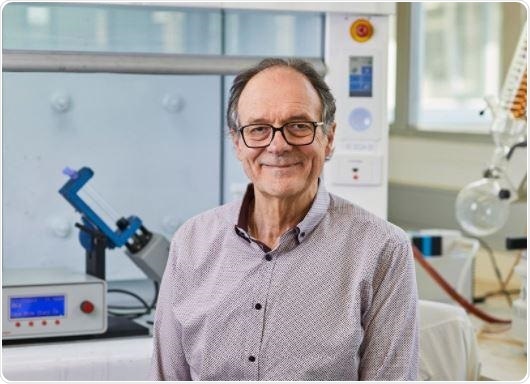Researchers at Flinders University previously gained worldwide attention by “unboiling” egg protein. Now, they have manipulated beta-lactoglobulin, or β-lactoglobulin—the major whey protein found in cows, sheep, and other mammals—by using an Australian-made innovative thin-film microfluidic device.

Professor of Clean Technology at Flinders University, Colin Raston. Image Credit: Flinders University.
Named the Vortex Fluidic Device, the thin-film microfluidic device was earlier used in a range of experiments to successfully “un-boil” egg protein and even disintegrate the molecular bonds of one of the hardest materials in the world—carbon nanotubes.
Experts from the College of Science and Engineering integrated the capabilities of the VFD with a new kind of biosensor known as TPE-MI—an aggregation-induced emission luminogen (AIEgen). The study was recently published in Molecules.
“In the human body, protein folding is a regular process which in some cases may involve misfolding and aggregation such as in gene mutation, which can upset the balance,” stated Professor Youhong Tang, whose research concentrates on expanding AIEgen technologies.
One is example is the buildup of amyloid proteins, which is associated with diseases such as Alzheimer’s, Parkinson’s, and Huntington’s. Finding ways to monitor these protein levels—and even reversing high levels of these cellular aggregations—could lead to future therapies.”
Youhong Tang, Professor, College of Science and Engineering, Flinders University
According to Professor Colin Raston, SA Scientist of the Year who designed the VFD, the combination of both technologies gave birth to some potential results in the fields of medical discovery.
In this latest study, we showed how vital proteins can be manipulated—unfolded and refolded—using β-lactoglobulin, which is a relatively simple, low molecular weight protein. Combining VFD and AIE technologies provides a fully capable and robust method for controlling and monitoring the progress of protein denaturation and renaturation.”
Colin Raston, Professor, College of Science and Engineering, Flinders University
Now, the researchers will employ the combination of technologies on other proteins, focusing on those largely associated with Parkinson’s disease, Alzheimer’s disease, and Huntington’s disease.
Source:
Journal reference:
Hu, Q., et al. (2021) In Situ Monitored Vortex Fluidic-Mediated Protein Refolding/Unfolding Using an Aggregation-Induced Emission Bioprobe. Molecules. doi.org/10.3390/molecules26144273.